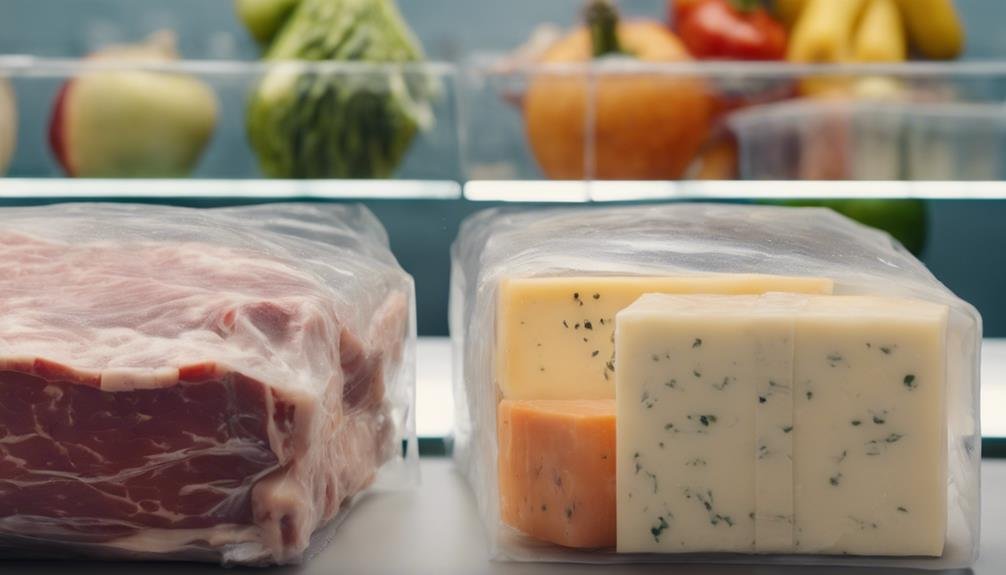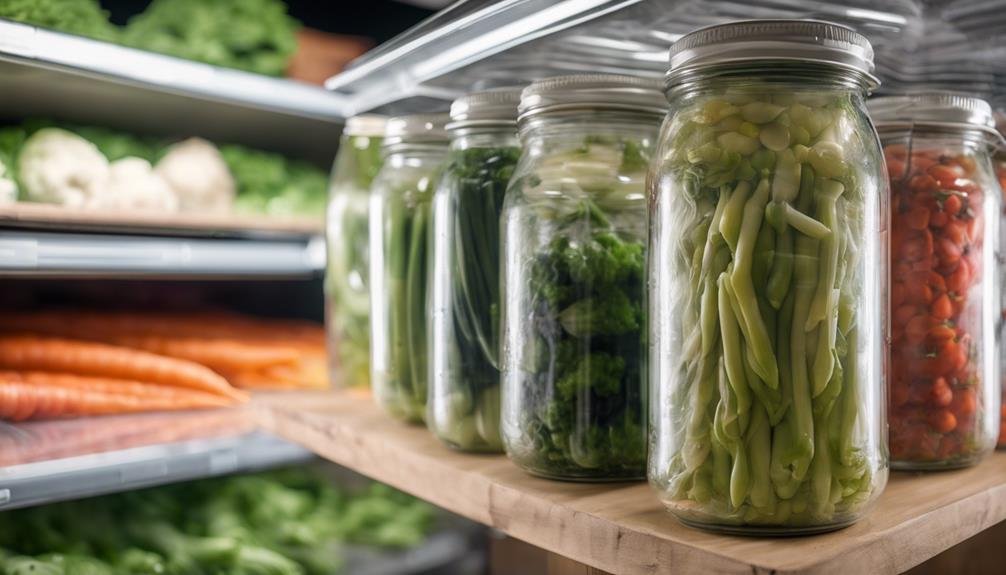Vacuum sealing extends food shelf life by removing oxygen, which slows bacterial growth and oxidation. It creates an airtight environment that preserves freshness, flavor, and nutrients. You'll find that meats can last 2-3 years in the freezer, while cheese and fruits stay fresh for 4-8 months in the fridge. Vegetables benefit from blanching before sealing. This method prevents freezer burn and maintains food quality far longer than traditional storage. You can even preserve dry goods like flour and pasta for up to 2 years. By combining vacuum sealing with proper storage temperatures, you'll maximize your food's longevity and reduce waste. Discover how this technology can revolutionize your food preservation methods.
Understanding Vacuum Sealing Technology
Vacuum sealing technology fundamentally revolutionizes food storage by removing oxygen from packaging, greatly extending the shelf life of various food items. This innovative method, also known as reduced oxygen packaging, helps retain food freshness and flavor far longer than traditional storage techniques. You'll find that vacuum sealing can extend the shelf life of food up to five times, making it an excellent choice for those looking to minimize waste and maximize their food budget.
When you use vacuum sealing technology, you're fundamentally creating an environment that slows down the natural decay process of food. By removing oxygen, you're inhibiting the growth of bacteria and other microorganisms that cause spoilage. This is particularly beneficial for preserving raw meats, as it helps maintain their color, texture, and nutrient content.
For enhanced efficiency in food preservation, you can combine vacuum sealing with oxygen absorber packets. These small sachets further reduce the oxygen levels inside the packaging, providing an extra layer of protection.
Whether you're storing leftovers, bulk purchases, or preparing meals in advance, vacuum sealing offers a reliable solution for keeping your food fresher for longer.
Benefits of Vacuum Sealed Food
Have you ever wondered why more people are turning to vacuum sealing for their food storage needs? The answer lies in the impressive benefits of vacuum sealed food. With this technique, you can prolong the shelf life of your food up to five times longer than traditional storage methods.
Vacuum packaging is particularly effective for preserving meats. Your beef, poultry, and fish can stay fresh for an incredible 2-3 years when properly vacuum sealed and frozen. This method also prevents freezer burn, ensuring your food maintains its quality and taste.
When it comes to vegetables, it's important to blanch them before vacuum sealing. This simple step allows them to last up to 2-3 years in the freezer.
Even in the refrigerator, vacuum sealed food lasts longer. Cheese, fruits, and berries can remain fresh for 4-8 months, compared to just 1-2 weeks with conventional storage.
Vacuum Sealing Different Food Types

Now that we've explored the benefits, let's examine how vacuum sealing affects various food types differently.
Vacuum sealing can notably extend the shelf life of different foods, depending on how they're stored. When stored in the freezer, vacuum-sealed meats can last fresh longer, up to 2-3 years compared to just 6 months without sealing. This food vacuum technique is particularly effective in preventing the growth of bacteria and preserving taste and texture.
For refrigerated items, vacuum sealing can work wonders too. Cheese, fruits, and berries can stay fresh for 4-8 months instead of the usual 1-2 weeks. Vegetables benefit greatly from this method as well, especially when blanched before sealing.
Dry foods also experience extended shelf life when vacuum-sealed. Here's how long some common pantry items can last:
- Flour: up to 2 years
- Rice: up to 2 years
- Pasta: up to 2 years
Storage Conditions for Vacuum Sealed Food
Proper storage conditions are essential for maximizing the benefits of vacuum-sealed food. To extend shelf life, you'll need to focus on removing oxygen from the packaging, which slows down bacterial growth. This process is vital for preserving food integrity and preventing freezer burn.
When you vacuum seal food, you're creating an environment that can greatly prolong its usability. Here's a quick guide to help you understand the potential shelf life of various vacuum-sealed foods:
| Food Type | Freezer Storage | Refrigerator Storage |
|---|---|---|
| Raw Meats | 2-3 years | N/A |
| Vegetables | 2-3 years | N/A |
| Cheese | N/A | 4-8 months |
| Fruits | N/A | 4-8 months |
To achieve these extended storage times, you'll need to maintain proper sealing and storage conditions. For freezer storage, keep a consistent temperature below 0°F (-18°C). For refrigerated items, keep the temperature between 34°F and 40°F (1°C to 4°C). Remember, while vacuum sealing significantly extends shelf life, it doesn't eliminate the need for proper food handling and storage practices.
Comparing Shelf Life Extension Methods

While vacuum sealing offers impressive shelf life extension, it's worth examining how it stacks up against other food preservation methods you might consider for your kitchen.
When comparing vacuum sealing to traditional storage methods, the benefits are clear:
- Meats preservation: Vacuum sealing extends the shelf life of beef, poultry, and fish from 6 months to 2-3 years in the freezer.
- Vegetables preservation: After blanching, vacuum-sealed veggies last 2-3 years in the freezer, compared to just 8 months with conventional freezing.
- Cheese and fruits preservation: In the refrigerator, vacuum-sealed cheese, fruits, and berries stay fresh for 4-8 months, while they typically last only 1-2 weeks using traditional methods.
Vacuum sealing outperforms other food storage methods by maintaining food integrity and preventing freezer burn for up to 2-3 years. This technique extends shelf life up to five times longer than conventional storage.
It's particularly effective for preserving a wide range of foods, from meats and vegetables to cheese and fruits. When you're looking to maximize the longevity of your food and reduce waste, vacuum sealing stands out as a superior method for shelf life extension.
Conclusion
You've seen how vacuum sealing can dramatically extend food's shelf life. But is it really as effective as claimed? While it's true that removing air slows spoilage, the results vary widely by food type and storage conditions.
Don't assume vacuum sealing is a cure-all. It's most effective when combined with proper refrigeration or freezing. For best results, research the most suitable techniques for specific foods you're preserving.
Experiment and find what works best for your needs.
